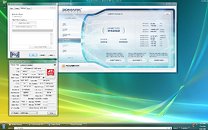- Joined
- Oct 9, 2007
- Messages
- 47,853 (7.39/day)
- Location
- Dublin, Ireland
| System Name | RBMK-1000 |
|---|---|
| Processor | AMD Ryzen 7 5700G |
| Motherboard | Gigabyte B550 AORUS Elite V2 |
| Cooling | DeepCool Gammax L240 V2 |
| Memory | 2x 16GB DDR4-3200 |
| Video Card(s) | Galax RTX 4070 Ti EX |
| Storage | Samsung 990 1TB |
| Display(s) | BenQ 1440p 60 Hz 27-inch |
| Case | Corsair Carbide 100R |
| Audio Device(s) | ASUS SupremeFX S1220A |
| Power Supply | Cooler Master MWE Gold 650W |
| Mouse | ASUS ROG Strix Impact |
| Keyboard | Gamdias Hermes E2 |
| Software | Windows 11 Pro |
Eran Badit of NGOHQ.com successfully modified NVIDIA CUDA (Compute Unified Device Architecture) to operate on an ATI GPU and has been able to run the NVIDIA PhysX layer on an RV670, the Radeon HD 3850.
He tells that enabling PhysX support on Radeon cards is not particularly difficult, leading us to believe that physics on graphics cards may not so much be a technology problem but an issue of corporate dynamics.
On his first run, Eran got a 22,606 CPU score in 3D Mark Vantage, enhancing the overall score to P4262. A comparable system without PhysX-support will cross the finish line at about P3800.

View at TechPowerUp Main Site
He tells that enabling PhysX support on Radeon cards is not particularly difficult, leading us to believe that physics on graphics cards may not so much be a technology problem but an issue of corporate dynamics.
On his first run, Eran got a 22,606 CPU score in 3D Mark Vantage, enhancing the overall score to P4262. A comparable system without PhysX-support will cross the finish line at about P3800.

View at TechPowerUp Main Site
Last edited:








 NVidia
NVidia